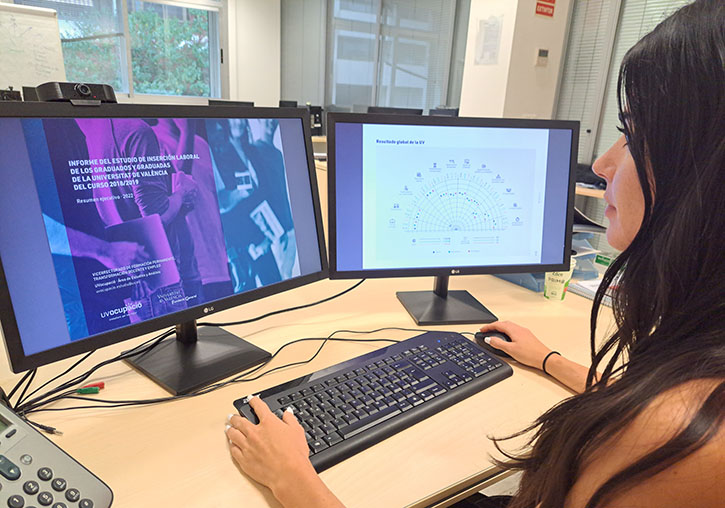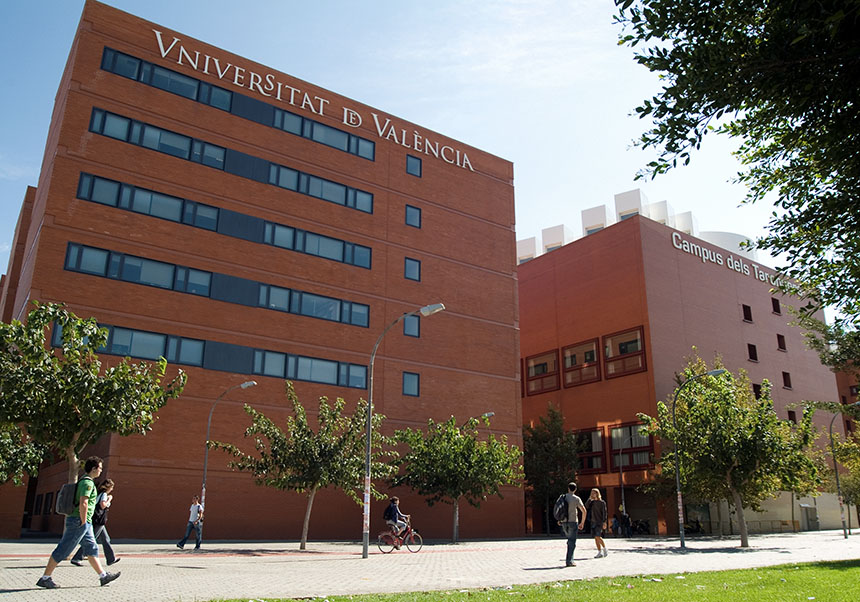More than 85% of UV students find a job within two years of graduation
- Press Office
- September 13rd, 2022

The employment rate of students at the Universitat de València two years after graduation is 85.4%, according to the fourth study of labour market insertion of the UV degrees, conducted by UVJob (UVOcupació), a service that depends on the General Foundation of the University. The crisis caused by the COVID-19 has not affected the employment rate or the other main indicators of employability, which remain similar to the third study (2020).
The fourth update has analysed the labour market outcomes of the graduates of the 2018-19 academic year, who were interviewed at the end of 2021. A total of 62 degrees were studied (56 Degrees and 6 Double Degrees). For the first time, the insertion of the Degree in Gastronomic Sciences, the Double Degree in Tourism and Business Management and Administration and the Double Degree in Pharmacy and Human Nutrition and Dietetics. A new feature is the inclusion of data on the integration of people with disabilities.
The indicator of the adjustment of the graduates’ current/last job to the level of studies and degree (that the job requires a university degree and that it is related to the degree studied) is 62%, similar to the previous study.
The percentage of people in employment six months after finishing the course is 73.3%, and stands out above all in the degrees of the School of Engineering (ETSE), at 83.7%. This fast integration is partly due to the high percentage of graduates who were hired by the same company where they did their internships.
With regard to the percentage of graduates who occupy technical positions or have people in their charge, the percentage is 64.5%, with the branches of Sciences, health Sciences and Architecture and Engineering standing out. The net monthly salary of graduates working full-time and employed is 1,396.8 euros, but reaches 1,606.7 euros in Architecture and Engineering and 1,450.6 euros in Health Sciences.
Branches of knowledge
By branches of knowledge, Health Sciences and Architecture and Engineering stand out, mainly the latter. The branch of Architecture presents the best data in most indicators. The percentage of graduates in this branch with stable contract is 61.5%, almost double that of the rest. The net monthly salary of graduates in this specialty is 1,606.7 euros, with a difference of around 150 euros with respect to the next one, Health Sciences, with a net monthly salary of 1,450.6 euros. It also presents better data for the activity rate (95.7%) and employment rate (93.2%).
The specialty of Health Sciences presents the best indicator of adjustment of the current/last job of the graduates to the level of studies and the degree, with 82.2%. It also presents the highest percentage in the indicator of self-employed. Even so, it decreases by almost 4 percentage points compared to the third survey, as in the previous surveys, and shows a downward trend in self-employment over time.
The branch of Arts and Humanities has the singularity of presenting better data for women than for men. With an employment rate of 80% for women compared to 67.2% for men, an adjustment of the current/last job of graduates to the level of studies and qualification of 57.7% for women and 34.9% for men or a net monthly salary of 1,450.2 euros for women and 1,361.6 euros for men.
Regarding the branch of Social Sciences, the study of labour market insertion presents a high rate of employment with a figure of 87.1%, highlighting the rapid labour market insertion of women (76.1%) six months after graduation, which is the highest among all the branches in the report. Likewise, 36.7% of the graduates had a table contract (36.7%) at the time of the survey.
Finally, the Science branch stands out for the high rate of jobs as a technician or with dependants, where three out of four respondents (75.8%) had a skilled job. On the other hand, Science is the second branch with the second highest percentage of full-time employees, 73.4%.
Degrees
Among the degrees with the best insertion are the Degree in Catalan Studies, the Double Degree in Pharmacy and Human Nutrition and Dietetics, the degree in Dentistry, the Double Degree in Business Administration and Management and Law, the Degree in Optics and Optometry and the Degrees in Telecommunications Electronic Engineering, Industrial Electronic Engineering and Computer Engineering. The latter is the only one with both an employment rate and an activity rate of 100%.
The degrees that have improved the most with respect to the third study are the degrees in Biotechnology and Labour Relations and Human Resources, mainly in the indicator of the adjustment of the graduates’ current/last job to their level of studies and degree, with an improvement of more than 20 percentage points.
Fourth Labour Market Insertion Study
The data are broken down by sex, at the level of university, branch of knowledge, degree and, as a novelty with respect to the previous study, faculty. This latest Insertion Study has been presented by UVJob’s Research and Analysis Department, coordinated by the Professor María del Carmen Bas. In addition, all data broken down by degree will soon be available interactively through the EstIL application, and individualised reports that will be found in the labour market insertion tab of each of the files of the degrees, and on the UVJob website with more detailed information and detailed indicators of labour market insertion of each of the degrees analysed. In this way, interested parties will be able to find out more comfortably what the labour market situation is for a specific degree and will thus be able to assess the situation of the labour market and the suitability of the study plans for a specific degree, among many other facilities.
File in: Fundació General UV , UVemployement , Estudis i anàlisis , Ocupació















